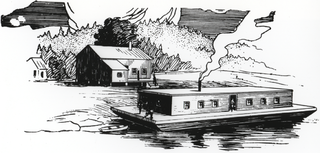The Constitution of Canada is the supreme law in Canada. It outlines Canada's system of government and the civil and human rights of those who are citizens of Canada and non-citizens in Canada. Its contents are an amalgamation of various codified acts, treaties between the Crown and Indigenous Peoples, uncodified traditions and conventions. Canada is one of the oldest constitutional monarchies in the world.
Canadian federalism involves the current nature and historical development of the federal system in Canada.
The Implied Bill of Rights is a judicial theory in Canadian jurisprudence that recognizes that certain basic principles are underlying the Constitution of Canada.
The Constitution Act, 1982 is a part of the Constitution of Canada. The Act was introduced as part of Canada's process of patriating the constitution, introducing several amendments to the British North America Act, 1867, including re-naming it the Constitution Act, 1867. In addition to patriating the Constitution, the Constitution Act, 1982 enacted the Canadian Charter of Rights and Freedoms; guaranteed rights of the Aboriginal peoples of Canada; provided for future constitutional conferences; and set out the procedures for amending the Constitution in the future.

The Constitution Act, 1867 is a major part of the Constitution of Canada. The Act created a federal dominion and defines much of the operation of the Government of Canada, including its federal structure, the House of Commons, the Senate, the justice system, and the taxation system. The British North America Acts, including this Act, were renamed in 1982 with the patriation of the Constitution ; however, it is still known by its original name in United Kingdom records. Amendments were also made at this time: section 92A was added, giving provinces greater control over non-renewable natural resources.
Pith and substance is a legal doctrine in Canadian constitutional interpretation used to determine under which head of power a given piece of legislation falls. The doctrine is primarily used when a law is challenged on the basis that one level of government has encroached upon the exclusive jurisdiction of another level of government.
Canadian constitutional law is the area of Canadian law relating to the interpretation and application of the Constitution of Canada by the courts. All laws of Canada, both provincial and federal, must conform to the Constitution and any laws inconsistent with the Constitution have no force or effect.

Reference Re Validity of Section 5(a) of the Dairy Industry Act (1949), also known as the Margarine Reference or as Canadian Federation of Agriculture v Quebec (AG), is a leading ruling of the Supreme Court of Canada, upheld on appeal to the Judicial Committee of the Privy Council, on determining if a law is within the authority of the Parliament of Canada's powers relating to criminal law. In this particular case, the Court found that a regulation made by Parliament was ultra vires. Though the regulation contained sufficient punitive sanctions, the subject matter contained within it was not the kind that served a public purpose.
Section 92(13) of the Constitution Act, 1867, also known as the property and civil rights power, grants the provincial legislatures of Canada the authority to legislate on:
13. Property and Civil Rights in the Province.

Ontario (AG) v Canada (AG), also known as the Local Prohibition Case, was a famous Canadian constitutional decision by the Judicial Committee of the Privy Council. It was one of the first cases to enunciate core principles of the federal peace, order and good government power.

Re Board of Commerce Act 1919 and the Combines and Fair Prices Act 1919, commonly known as the Board of Commerce case, is a Canadian constitutional decision of the Judicial Committee of the Privy Council in which the "emergency doctrine" under the federal power of peace, order and good government was first created.

Toronto Electric Commissioners v Snider is a famous Canadian constitutional decision of the Judicial Committee of the Privy Council where the Council struck down the federal Industrial Disputes Investigation Act, precursor to the Canada Labour Code. The Court identified matters in relation to labour to be within the exclusive competence of the province in the property and civil rights power under section 92(13) of the Constitution Act, 1867. This decision is considered one of the high-water marks of the Council's interpretation of the Constitution in favour of the provinces.

Reference Re Alberta Statutes, also known as the Alberta Press case and the Alberta Press Act Reference, is a landmark reference of the Supreme Court of Canada where several provincial laws, including one restricting the press, were struck down and the existence of an implied bill of rights protecting civil liberties such as a free press was first proposed.
Section 91(2) of the Constitution Act, 1867, also known as the trade and commerce power, grants the Parliament of Canada the authority to legislate on:
2. The Regulation of Trade and Commerce.
In Canadian Constitutional law, interjurisdictional immunity is the legal doctrine that determines which legislation arising from one level of jurisdiction may be applicable to matters covered at another level. Interjurisdictional immunity is an exception to the pith and substance doctrine, as it stipulates that there is a core to each federal subject matter that cannot be reached by provincial laws. While a provincial law that imposes a tax on banks may be ruled intra vires, as it is not within the protected core of banking, a provincial law that limits the rights of creditors to enforce their debts would strike at such a core and be ruled inapplicable.

Canada (AG) v Ontario (AG), also known as In re the Regulation and Control of Aeronautics in Canada and the Aeronautics Reference, is a decision of the Judicial Committee of the Privy Council on the interpretation of the Canadian Constitution. Lord Sankey decided in the case that the federal government has the authority to govern the subject of aeronautics, including licensing of pilots, aircraft, and commercial services and regulations for navigation and safety.
The Preamble to the Constitution Act, 1867 provides:
Whereas the Provinces of Canada, Nova Scotia, and New Brunswick have expressed their Desire to be federally united into One Dominion under the Crown of the United Kingdom of Great Britain and Ireland, with a Constitution similar in Principle to that of the United Kingdom:
And whereas such a Union would conduce to the Welfare of the Provinces and promote the Interests of the British Empire:
And whereas on the Establishment of the Union by Authority of Parliament it is expedient, not only that the Constitution of the Legislative Authority in the Dominion be provided for, but also that the Nature of the Executive Government therein be declared:
And whereas it is expedient that Provision be made for the eventual Admission into the Union of other Parts of British North America:

Canada (AG) v British Columbia (AG), also known as the Reference as to constitutional validity of certain sections of The Fisheries Act, 1914 and the Fish Canneries Reference, is a significant decision of the Judicial Committee of the Privy Council in determining the boundaries of federal and provincial jurisdiction in Canada. It is also significant, in that it represented a major victory in the fight against discrimination aimed at Japanese Canadians, which was especially prevalent in British Columbia in the early part of the 20th century.
Section 92(14) of the Constitution Act, 1867, also known as the administration of justice power, grants the provincial legislatures of Canada the authority to legislate on:
14. The Administration of Justice in the Province, including the Constitution, Maintenance, and Organization of Provincial Courts, both of Civil and of Criminal Jurisdiction, and including Procedure in Civil Matters in those Courts.

Reference re Pan‑Canadian Securities Regulation, 2018 SCC 48 is a landmark decision of the Supreme Court of Canada, dealing with the Canadian doctrine of cooperative federalism and how it intersects with the power of the Parliament of Canada over trade and commerce, as well as discussing the nature of parliamentary sovereignty in Canada.






